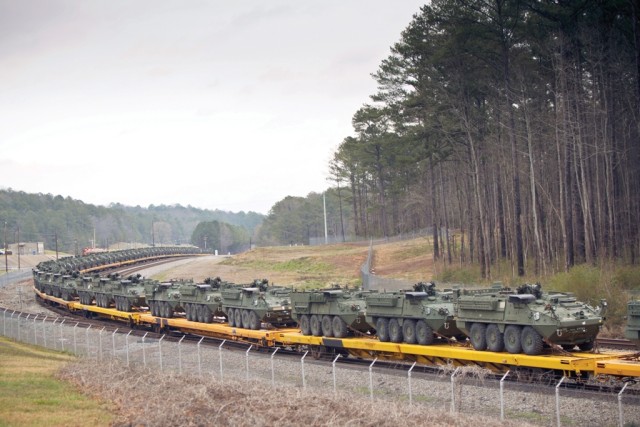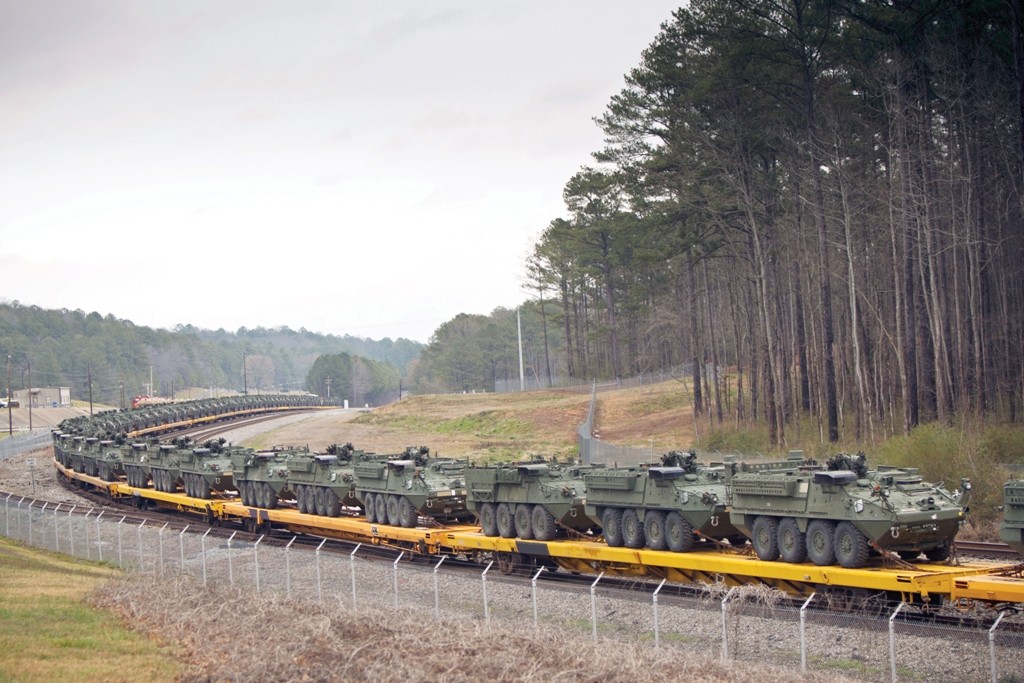ANNISTON ARMY DEPOT, Ala. - They toiled in the cold weather of Alaska and briefly visited the warmer climes of California, now 288 Stryker vehicles from the 1st Stryker Brigade Combat Team, 25th Infantry Division, otherwise known as the 1-25 SBCT, are here awaiting reset to mission capable status.
On March 10, the vehicles rolled onto Anniston Army Depot on rail cars. An additional eight vehicles being reset for the 1-25 SBCT will arrive at a later date.
All but one of the vehicles were able to be driven off the rail cars to the motor pool, which, according to Dale Williams, Stryker division chief, is a good sign this reset mission will go smoothly. The lack of engine deterioration can be attributed to none of the vehicles having slat armor.
"These vehicles were not equipped with the slat armor because they did not leave the United States," said Phillip Dean, chief of the depot's Integrated Logistics Support Office. "That weight puts additional wear and tear on the engines that we don't anticipate seeing on these vehicles."
The Strykers will be reset in a three-phase process by depot and General Dynamics Land Systems employees as part of a public-private partnership workshare agreement that began in 2009. The agreement, however, has roots as far back as 1993, when GDLS and the depot first partnered on M1 Abrams tanks.
"This reset continues to leverage the P3 we established on the M1 and Stryker programs," said Hank Kennedy, plant manager for GDLS. "This relationship has been nurtured throughout the years and, obviously, we both think it will be beneficial in the future."
Eight of the 10 Stryker variants are represented in this brigade's vehicles except for the Nuclear Biological Chemical Reconnaissance Vehicle and the Mobile Gun System.
"Working on the different variants is a challenge, especially for our mechanics, who have to keep up with the differences and know which components are unique to each," said Williams. "Because of this, we try to group vehicles of the same type together as they move through the maintenance processes."
Director of Production Jeff Simmons said the vehicles are currently undergoing a technical inspection, which will determine what maintenance needs to be performed on each Stryker.
"They go through and identify any missing or damaged parts so GDLS can go ahead and order those parts up front," said Simmons.
This is the fourth round of Stryker reset work undertaken by GDLS and depot workforces. The first, which began in November 2009, yielded 312 vehicles.
The second, for 73 vehicles, was performed in mid-2010. After that program was completed, 265 Strykers began to wind their way through the shops of the Nichols Industrial Complex.
As the last of those 265 leave the depot, the first of the 1-25 SBCT's Strykers will begin their reset journey.
"We will have an average production schedule of about 60 vehicles per month," said Simmons, adding that is not an unusual number for Stryker reset. "We've done 70 a month before, so 60 will be easy."
Throughout the process, the partners communicate frequently, ensuring a steady stream of needed parts from GDLS and that the work remains on schedule.
As the 1-25 SBCT's Strykers leave the installation this fall, a follow-on reset, another full brigade, is scheduled to arrive and the process will begin again.
"Workload on Strykers is very promising for the future," said Williams. "The troops I've talked to like these vehicles because they are fast. They enable the Soldiers to get in, do what they need to do and get out."


Social Sharing